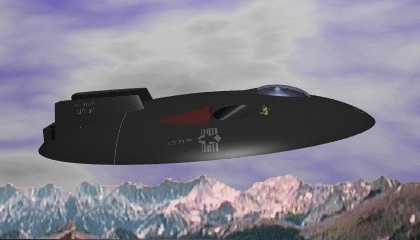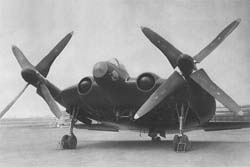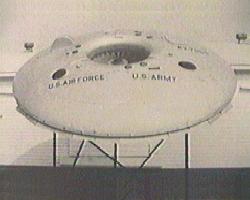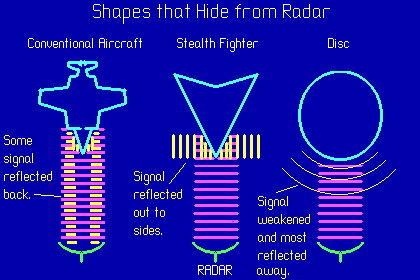pop up description layer
HOME
Cryptozoology UFO Mysteries Aviation Space & Time Dinosaurs Geology Archaeology Exploration 7 Wonders Surprising Science Troubled History Library Laboratory Attic Theater Store Index/Site Map Cyclorama
Search the Site: |
|
Real Flying Saucers
During the Second World War the United States was looking desperately for anything that could give its fighter pilots an edge in combat. So in 1942 the Navy ordered the construction of an experimental aircraft designated the XF5U-1: A flying saucer. In the years before the war an Aeronautics engineer named Charles Zimmerman became fascinated with the possibilities offered by an aircraft designed like a thin disc. Zimmerman, who worked for the National Advisory Committee on Aeronautics, tested a series of unmanned models that eventually led to this design. The shape, commonly referred to at the time as a "flying flapjack," would allow an aircraft to both perform well at high speeds by producing very little drag, and at low speeds, by resisting a stall. Most traditional aircraft designs have to make a trade off: Long wings let an airplane land and take off at very low speeds. This means shorter runways and greater payloads. As the speed increases, though, long wings create too much resistance to the air and waste power. That's why modern jet fighters have very short, stubby wings. They can go very fast, but they are difficult to land because if you fly them too slow they will not produce enough lift to keep the plane in the air (this is called a stall) and crash. Some modern jets, like the United State's F111 and F14 solve this problem by using a "swing wing" that could be changed from short and swept back to long and square depending on what the plane was trying to do. Zimmerman's design promised to do the same thing without the mechanical complexities associated with moving the wing in flight.
The idea was tested with a manned prototype called the V-173. The V-173 made over 100 successful flights, so two prototypes of a fighter, the XF5U1, were built. The XF5U-1 prototypes were powered by two 1600-horsepower engines which drove twin propellers on the front of the craft. The pilot sat in a bubble-like canopy that was roughly in the center of the saucer. Small vertical and horizontal tailfins were on the rear of the craft. Zimmerman estimated that the planes would have a top speed of 425 miles an hour and still be able to land as slow as 40 miles an hour. He hoped that with even more powerful engines the fighter might reach 550 miles an hour and be able to take off almost vertically. By the time the XF5U-1 was finished, though, the war was over and the Navy had become interested in jet powered aircraft of more conventional designs. The XF5U-1s never flew and were destroyed. There is some evidence that during WWII the Germans had some interest in disc shaped aircraft, too, though it seems unlikely that any of their designs were ever flight tested.
The project was originally funded by Canada, but later was taken over by the U.S. Air Force in 1954. The USAF was concerned that it would need a fighter capable of vertical takeoffs and the VZ-9V was seen as a possibility. The VZ-9V was about twenty feet in diameter with a five foot wide central fan. It flew well at low altitudes of five or six feet, but when it tried to rise further it became unstable. This had been recognized as a problem early on and the aircraft had a complex mechanical system that was supposed to automatically control the undesired movement and keep the craft stable. It never really worked, though, and, in 1961, after putting $10 million dollars into the project, the Air Force dropped it. Still, more aircraft designers found the saucer shape interesting. In 1954 Lockheed Aircraft Corporation, the same company that later built the super secret U-2 spy plane, SR-71 "Blackbird" and F-117A "Stealth Fighter", applied for a patent on a saucer shaped plane. Lockheed was convinced that the shape would allow for excellent structural rigidity, stable vertical ascent, inherent aerodynamic efficiency, and lots of room inside for fuel and payload. As far as anyone knows the Lockheed design was never built. One flying saucer that has been built is the Sikorsky Cypher. It is a flying robot about six feet in diameter designed for remote reconnaissance. Unlike the V-173 and similar designs, this saucer is not a wing, but a shroud for a rotary-wing. Operating like a helicopter it can hover and fly slowly around using its video camera to spy. Designed for military operations, the saucer-like shroud keeps the spinning rotor from coming in contact with tree limbs and wires as it maneuvers down tight city streets during urban warfare. The shape has another property that has become important in the last ten or twenty years of aircraft design: It is stealthy. Military radar works by sending a radio wave out from a radar transmitter. When the wave hits an object it reflects some of the wave back. A radar receiver located at the same place as the transmitter can then detect the wave. By knowing how long it took for the wave to return, what direction it returned, and if the frequency of the wave was shifted, the distance, location and speed of the object can be calculated and shown on the radar screen. Some objects reflect radio wave better than others. Flat objects will reflect a wave strongly in a particular direction. Circular or rounded objects reflect the wave more poorly because they scatter it in many directions. The F-117A and B-2 aircraft, known as the "Stealth Fighter" and "Stealth Bomber" respectively, hide by never reflecting radar waves back toward the radar receiver. In normal flight they are designed to present their perfectly flat surfaces away from potential radar sites at an angle. A competing stealth design, though, would use a rounded aircraft, like a saucer, to scatter the waves. Before photos of the F-117A were released many engineers speculated that the plane would be round and flat with a short, sharp, pointed nose at the forward end. Could the government be developing a super secret, vertical takeoff and landing, stealth flying disc somewhere (Perhaps at the famed Area 51)? Problems that plagued earlier designs, like the Avrocar, have been resolved. Computer fly-by-wire systems have made inherently unstable aircraft, like the F-117A, very flyable. There is no reason why the same thing couldn't be done for a jet powered flying saucer.
Copyright Lee Krystek 1996, 1998. All Rights Reserved. |
|
Related Links |
|
|





 The
next attempt to take advantage of the saucer shape was the VZ-9V
Avrocar (left - USAF). Avro
Aircraft, a British concern, designed an aircraft that was circular
in shape and used a central fan, powered by three turbo-jet engines,
to make a vertical takeoff. Once in the air the turbo-jet exhaust
would be shifted to the rear giving the vehicle the forward movement
it would need to let the circular wing generate lift.
The
next attempt to take advantage of the saucer shape was the VZ-9V
Avrocar (left - USAF). Avro
Aircraft, a British concern, designed an aircraft that was circular
in shape and used a central fan, powered by three turbo-jet engines,
to make a vertical takeoff. Once in the air the turbo-jet exhaust
would be shifted to the rear giving the vehicle the forward movement
it would need to let the circular wing generate lift.
